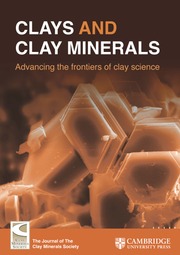Article contents
Sepiolite-Palygorskite: A Continuous Polysomatic Series
Published online by Cambridge University Press: 01 January 2024
Abstract
A compositional gap between sepiolite and palygorskite has long been accepted even though they have similar structures, but recent studies found that such a gap does not exist and that the compositional series is continuous between them. If this is true, intergrowths between these two minerals should exist. The purpose of the present study was to demonstrate the existence of sepiolite-palygorskite intergrowths in all possible proportions, in order to establish the compositional links between ideal sepiolite and ideal palygorskite and to define the compositional limits of these two minerals. Sepiolite and palygorskite have similar structures but different chemical compositions: sepiolite is the most trioctahedral and magnesic extreme, while palygorskite is dioctahedral with Al and Mg in its octahedral sheet. The existence of all intermediate compositions between these two pure extremes has led to the definition of the intermediate minerals, Al-sepiolite and Mg-palygorskite, which can have similar chemical composition. The structural relations between the different minerals of the palygorskite—sepiolite series were studied here by powder X-ray diffraction (XRD), and continuous variation in the chemical composition is explained by the existence of intergrowths of sepiolite and palygorskite polysomes forming a continuous polysomatic series. The existence of intergrowths by mixtures of polysomes in modulated structures can be considered in the same way that the mixed-layer minerals in layered structures are considered. The continuous polysomatic series of sepiolite-palygorskite can be expressed by the general formula: [Si12Mg8O30(OH)4(OH2)4]y∙[Si8O20(Mg2Fe2)x(Mg2Al2)(1-x)(OH)2(OH2)4](1-y)·nH2O, where sepiolite and palygorskite are the end-members. They and xvalues can be calculated using a ternary plot with the oxide contents of the main octahedral cations (Al2O3, Fe2O3, and MgO). The proposed model, which is based on the intergrowth of sepiolite and palygorskite polysomes, explains both the variability in the chemical composition and the compositional limit for the identification of these minerals by X-ray diffraction.
Keywords
Information
- Type
- Article
- Information
- Copyright
- Copyright © Clay Minerals Society 2013
References
- 38
- Cited by

